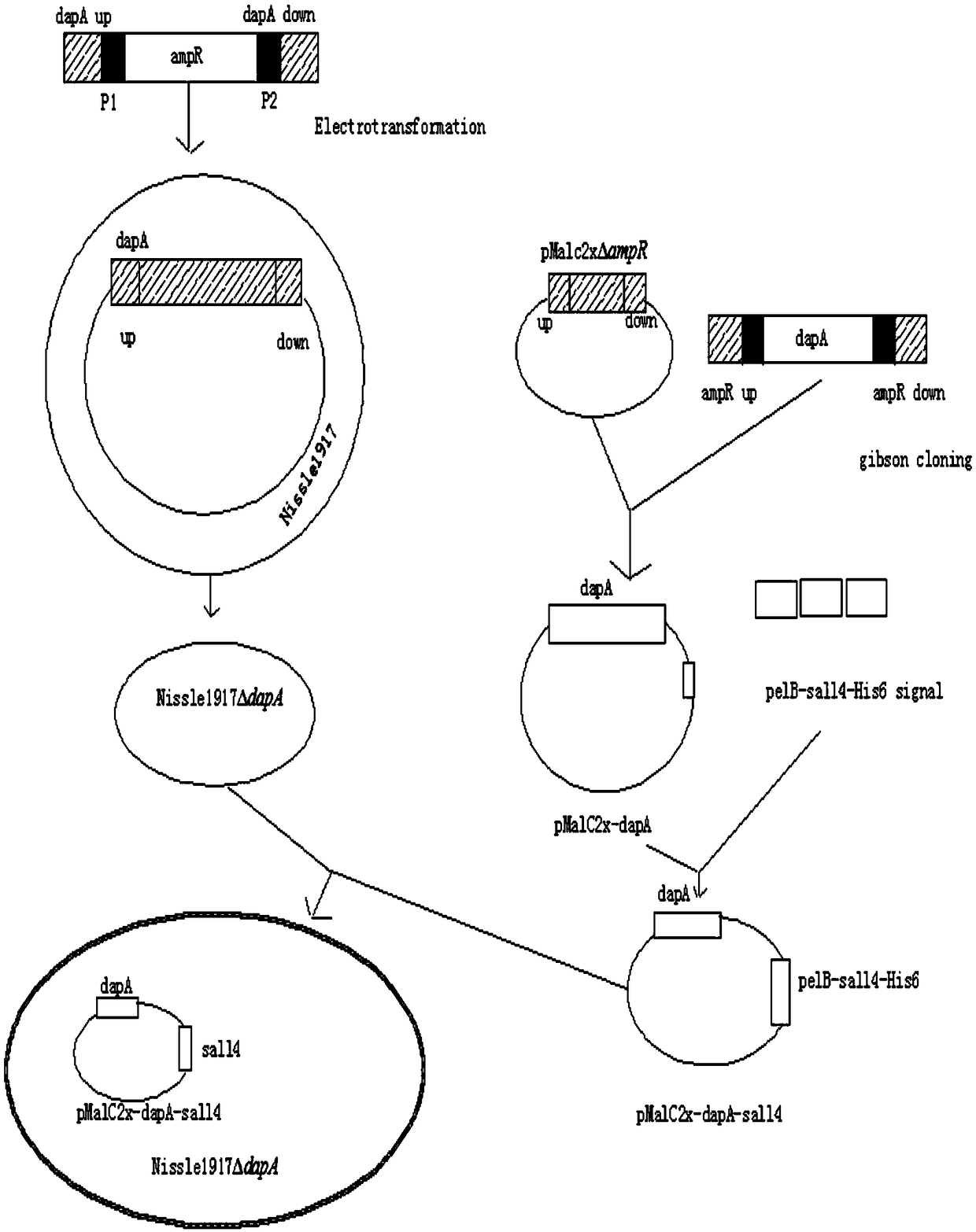Gene modification based method for expressing exogenous drug through probiotic and application of method
A technology of genetic modification and probiotics, applied in the field of genetic engineering, can solve problems such as inability to maintain a physiological state, lack of kanamycin resistance genes, etc., and achieve the goal of reducing application costs, improving safety and high efficiency, and reducing toxic and side effects Effect
- Summary
- Abstract
- Description
- Claims
- Application Information
AI Technical Summary
Problems solved by technology
Method used
Image
Examples
Embodiment 1
[0040] Embodiment 1: obtain the Nissle1917 bacterial strain of GFP mark
[0041] Such as figure 1 As shown, by designing primers, such as the nucleotide sequence shown in SEQ ID NO.1-2 of the sequence table: primer GFP-F: ATGACTATGATTACGGATTCTCTGGCCGTCGTATTACAACGTCGTGACTGTTTGCCCGCCAGTTGTTG, primer GFP-Re: CAGCTCCAGCCTACAAGGCTGGAGCTGCTTCTTAG, using the SAD1702 genome as a template, through the polymerase chain The reaction (PCR) obtained a 1359bp GFP gene fragment. Design primer simultaneously, as the nucleotide sequence shown in sequence table SEQ ID NO.3~4: primer Cm-F:AAGCAGCTCCAGCCTTGTAGGCTGGAGCTGCTTC, primer Cm-Re:TTATTTTTGACACCAGACCAACTGGTAATGGTAGCGACCGGCGCTCAGCTTCCTCCTTAGTTCCTATTCC, with pKD3 as template, PCR obtains 1082bp of chloramphenicol (Cm ) gene fragments, the two are linked together by overlap PCR. The conditions of the polymerase chain reaction are: 94°C for 2 minutes, 94°C for 20 seconds, 52°C for 30 seconds, 72°C for 1 minute and 15 seconds, 35 cycles, and ...
Embodiment 2
[0042] Example 2: Construction of Escherichia coli auxotrophic strain Nissle1917ΔdapA
[0043] The gene knockout method uses the lamda-Red recombination one-step knockout method. Operation process: clone the recombinant fragment, design primers, such as the nucleotide sequence shown in SEQ ID NO.5-6 of the sequence table: primer DapA-Km-For:TGTTCACGGGAAGTATTGTCGCGATTGTTACTCCGATGGATGTGGGCTGGAGCTGCTTC, primer DapA-Km-Re:TACAGCAAACCGGCATGCTTAAGCGCCGCTCTGACCGTCTCTCCTTAGTTCCTATTCC, which contains 40bp Knock out the upstream and downstream genes of the homology arm of the target gene dapA and the 20bp cloned resistance gene kan, upstream and downstream sequences, and use agarose gel to recover and purify the recombinant fragments. Escherichia coli Nissle1917 competent cells transformed with the recombinant plasmid pKD46 by electric shock were spread on LB plates containing 20 μg / ml Kan antibiotic and 20% arabinose. Pick a single colony on the resistant plate, use the detection prim...
Embodiment 3
[0044] Example 3: Construction and transformation of complementary plasmids for auxotrophic strains
[0045] Design primers, use the Nissle1917 genome as a template, and amplify the 869bp dapA gene fragment by PCR. The PCR reaction conditions are: 94°C, 2 minutes, 94°C, 20 seconds, 52°C, 30 seconds, 72°C, 1 minute, 32 pieces Cycle, PCR product is purified, obtain dapA gene fragment, design primer, nucleotide sequence as shown in sequence table SEQ ID NO.7~8: pMl-DapA-For:GCAGGTCGACTCTAGATTACAGCAACCGGCATGC, pMal-DapA-Re:CAAGGACCATAGCATATGTTCACGGGAAGTATTG, with pMalc2x The plasmid was used as a template, and the pMalc2xΔampR fragment without ampR was amplified by PCR. The two PCR products were mixed and ligated by Gibson cloning. Nissle 1917 competent cells of pKD46 were spread on DAP-free LB plate, cultured at 37°C for 14-16 hours, picked 5 colonies and inoculated in LB culture medium, cultivated for 5-6 hours, detected the bacteria liquid by PCR, The PCR product was detected ...
PUM
 Login to View More
Login to View More Abstract
Description
Claims
Application Information
 Login to View More
Login to View More - R&D
- Intellectual Property
- Life Sciences
- Materials
- Tech Scout
- Unparalleled Data Quality
- Higher Quality Content
- 60% Fewer Hallucinations
Browse by: Latest US Patents, China's latest patents, Technical Efficacy Thesaurus, Application Domain, Technology Topic, Popular Technical Reports.
© 2025 PatSnap. All rights reserved.Legal|Privacy policy|Modern Slavery Act Transparency Statement|Sitemap|About US| Contact US: help@patsnap.com



